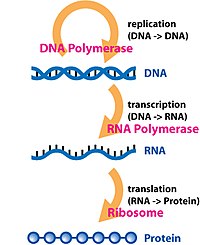
Photo from wikipedia
BackgroundAlternative polyadenylation (APA) results in messenger RNA molecules with different 3′ untranslated regions (3’ UTRs), affecting the molecules’ stability, localization, and translation. APA is pervasive and implicated in cancer. Earlier… Click to show full abstract
BackgroundAlternative polyadenylation (APA) results in messenger RNA molecules with different 3′ untranslated regions (3’ UTRs), affecting the molecules’ stability, localization, and translation. APA is pervasive and implicated in cancer. Earlier reports on APA focused on 3’ UTR length modifications and commonly characterized APA events as 3’ UTR shortening or lengthening. However, such characterization oversimplifies the processing of 3′ ends of transcripts and fails to adequately describe the various scenarios we observe.ResultsWe built a cloud-based targeted de novo transcript assembly and analysis pipeline that incorporates our previously developed cleavage site prediction tool, KLEAT. We applied this pipeline to elucidate the APA profiles of 114 genes in 9939 tumor and 729 tissue normal samples from The Cancer Genome Atlas (TCGA). The full set of 10,668 RNA-Seq samples from 33 cancer types has not been utilized by previous APA studies. By comparing the frequencies of predicted cleavage sites between normal and tumor sample groups, we identified 77 events (i.e. gene-cancer type pairs) of tumor-specific APA regulation in 13 cancer types; for 15 genes, such regulation is recurrent across multiple cancers. Our results also support a previous report showing the 3’ UTR shortening of FGF2 in multiple cancers. However, over half of the events we identified display complex changes to 3’ UTR length that resist simple classification like shortening or lengthening.ConclusionsRecurrent tumor-specific regulation of APA is widespread in cancer. However, the regulation pattern that we observed in TCGA RNA-seq data cannot be described as straightforward 3’ UTR shortening or lengthening. Continued investigation into this complex, nuanced regulatory landscape will provide further insight into its role in tumor formation and development.
Journal Title: BMC Genomics
Year Published: 2018
Link to full text (if available)
Share on Social Media: Sign Up to like & get
recommendations!